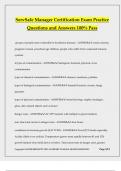ServSafe Manager Certification Exam Practice
Questions and Answers 100% Pass
groups of people most vulnerable to foodborne diseases - ANSWER✔✔-senior citizens,
pregnant women, preschool age children, people who suffer from weakened immune
systems
4 types of contamination - ANSWER✔✔-biological, chemical, physical, cross
contamination
types of chemical contamination - ANSWER✔✔-cleaners, sanitizers, polishes
types of biological contamination - ANSWER✔✔-harmful bacteria, viruses, fungi,
parasites
types of physical contamination - ANSWER✔✔-metal shavings, staples, bandages,
glass, dirt, natural objects such as bones
danger zone - ANSWER✔✔-41º-135º bacteria will multiply in great numbers
max time food can be in danger zone - ANSWER✔✔-four hours
conditions for bacteria growth (FAT TOM) - ANSWER✔✔-Food (TCS foods especially,
Acidity (little to no acidity), Temperature (grows most rapidly between 41 and 135)
growth limited when held above or below, Time (more time in danger zone, greater
Copyright ©SOPHIABENNETT 2025 ACADEMIC YEARALL RIGHTS RESERVED. Page 1/13
, change of growing to unsafe levels), Oxygen (some need, some don't), Moisture (food
with high levels of moisture, aw=water activity; the amount of moisture available in
food for bacterial growth, scales from 0.0-1.0, water has 1.0)
TCS food - ANSWER✔✔-milk and dairy products, meat (beef, pork, lamb), fish, baked
potatoes, tofu or other soy protein, synthetic ingredients (textured soy protein in meat
alternatives), sliced melons, cut tomatoes, cut leafy greens, shell eggs (except when
treated to eliminate salmonella), poultry, shellfish and crustaceans, heat treated plant
food (beans, rice, vegetables), sprouts and sprout seeds, untreated garlic and oil
mixtures
bacteria produced toxins - ANSWER✔✔-toxins that are produced by bacteria cannot be
killed by heat or cold
spores - ANSWER✔✔-created by bacteria, won't reproduce unless conditions are right,
have a thick shell
costs of foodborne illness to an operation - ANSWER✔✔-loss of customers and sales,
loss of reputation, negative media exposure, lowered staff morale, lawsuits and legal
fees, staff missing work, increased insurance premiums, staff retraining
5 risk factors for foodborne illness - ANSWER✔✔-1) purchasing food from unsafe
sources 2) failing to cook food correctly 3) holding food at incorrect temperatures 4)
using contaminated equipment 5) practicing poor personal hygiene
Copyright ©SOPHIABENNETT 2025 ACADEMIC YEARALL RIGHTS RESERVED. Page 2/13




